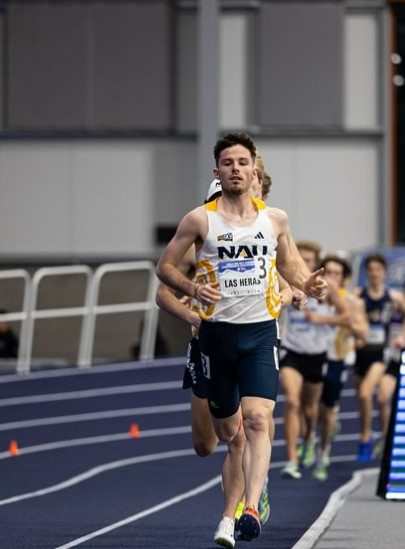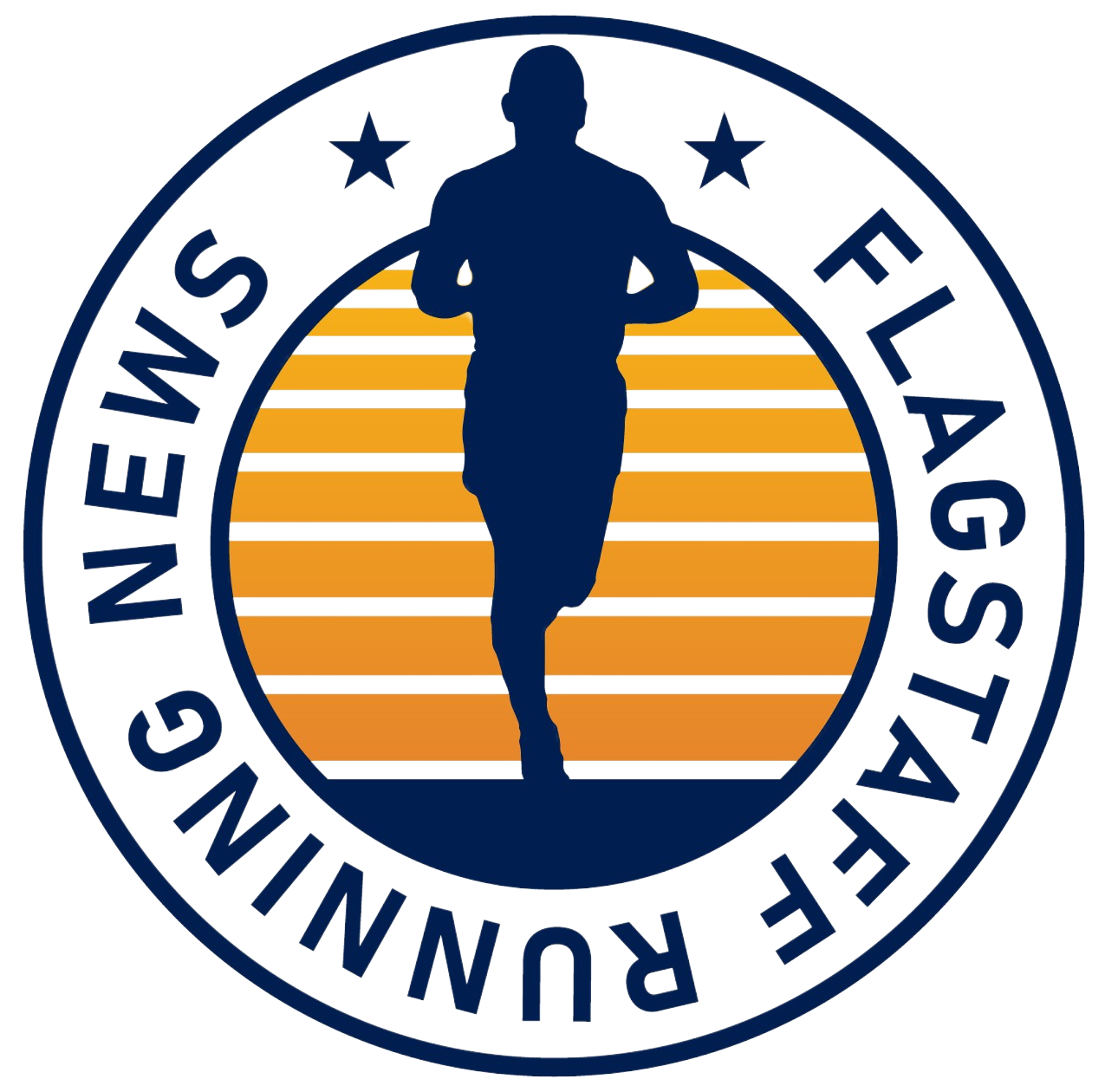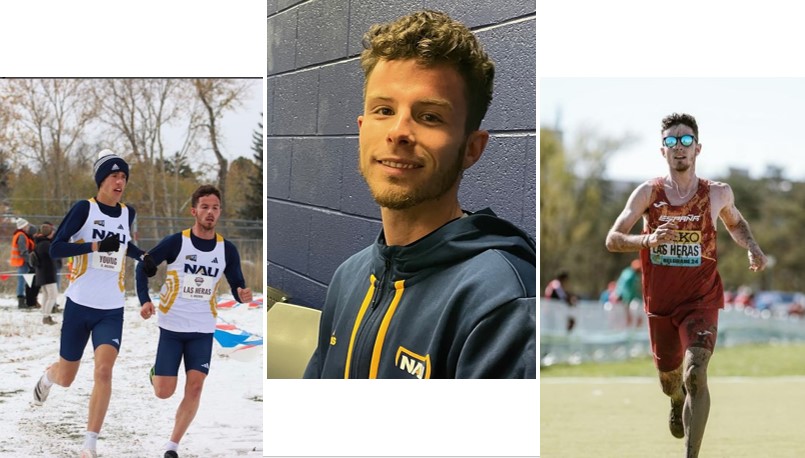Graduate transfer coming off 17th place finish at World Cross Country; now eyeing NCAAs and Olympic 5K Standard
Back in Barcelona, when he was still a teenager and nursing lingering doubts about his running ability, Aaron Las Heras would watch videos from U.S. collegiate races. He remembers one vividly: the 2017 NCAA Cross Country Championships, won by NAU with a dominant 53-point victory over Portland.
“Watching Matt Baxter and (Tyler) Day go out in front like that and the team winning,” said Las Heras, shaking his head at the memory, “and I was like, this is the best school ever.”
But …
“I never approached the coaches and talked to them,” Las Heras, now 23, added, “because I thought it would be too much for me, like, I wasn’t good enough. Now, I wish I’d come (here) earlier. Every day I wake up in Flagstaff, I regret not coming earlier.”
Jump ahead to 2023, and Las Heras still was sort of pining for the ponderosa pines of Flagstaff and the running program at NAU. He was completing his undergraduate business degree while running for Wake Forest University.
His running career at the university in Winston-Salem, N.C. had progressed in fits and starts, interrupted by injuries, but he’d shown great promise – particularly when he went back to his native Spain and competed internationally in U-23 meets. But after he finished, in his estimation, a disappointing 26th in the 2022 cross country nationals, a race in which NAU again won the team title, Las Heras felt old enough and bold enough now to finally consider the Lumberjack program.
Because of Covid, many runners received an extra year of eligibility, so fifth-year seniors were entering the NCAA’s transfer portal in record numbers, wanting to finish their careers and do graduate study at another institution.
So, Las Heras took the plunge. His plan in November of 2022 of ’23 was to finish up his spring at Wake Forest, running track for the Demon Deacons before transferring, via the portal, elsewhere – ideally, NAU. His roadmap abruptly changed, however, shortly after November when he informed the Wake Forest coaching staff of his portal plans.
“It didn’t end well,” he said, smiling ruefully. “Even though I communicated that I was going into the transfer portal, I felt like we (he and Wake Forest coaches) had made it clear that I was still going to be on the team (for spring track). But I got kicked off the team. So, for the spring semester, I was all on my own and not able to work out with my teammates. That was a big change.”
By necessity, from November of 2022 to August of 2023, Las Heras had a new coach – himself.
He’d had entered the portal knowing that NAU was the place he wanted to finish his college career but, as a backup, he checked the box that allowed all college coaches to contact him, rather than the other way around. He drew a lot of interest, not surprisingly because Las Heras had the rare combination of being a standout 10K runner who also could churn out a speedy 1,500-meter time. That versatility is hard to come by, and Oregon and Ole Miss, in particular, came calling.
But for Las Heras, it was NAU or bust.
“I made a visit that Thanksgiving to NAU – I almost wanted to come here the same day,” said Las Heras, who will compete with NAU tonight in the Bryan Clay Classic 10,000 meters to attain the NCAA Regionals qualifying mark. “Even before I came here for the visit, I knew the culture, the coaching, the success.”

He, officially, was announced as an NAU graduate transfer late last May, after the NCAA outdoor had concluded. By then, Las Heras had been denied the outdoor collegiate season and had gone six months without any coaching and training with others. (He may run in the 10K and 5K in NCAAs for NAU this time around.)
“I came (to Wake Forest) as an 18-year-old. I came through plenty of injuries, plenty of things going on. New country. New culture. New language. I wasn’t fluent at that time. It was a long process to get used to it. My time there wasn’t perfect all the time. Ups and downs.”
Aaron Las Heras
It could have been perceived as a lonely time for Las Heras, but he took it as a challenge to do the work himself.
“I wrote my own programs,” Las Heras recalled. “I trained by myself. I just did what I thought was best for me in the long run for cross country this (past) season (at NAU). I think it worked out well. I kind of did a mini-outdoors season, doing four races in just 10 days back home (with his Spanish club team).
“Those four months (on his own in Winston-Salem), I felt like I made a lot of improvements, just not worrying about competition and sticking to training. I was getting mentally stronger every day. Not having my teammates there, and not having a coach, being away from home – it was hard. I almost wanted to leave the place. My mind was already more here (at NAU). Also, Mike Smith didn’t have the power to coach me; that was not allowed.”
Improve, he certainly did.
Las Heras lowered his 5,000-meter personal best 11 seconds, running 13:27.47 at the Meeting Iberamericano in Huelva on June 6, then came back a weeks later to lower his 1,500 meter personal best by five second, running 3:36.39 at the VII Memorial Jose Antonio Cansino in Castellon de La Plana.
All the while, he was trying to come to terms with how his Wake Forest career ended, and hopefully looking ahead to better days in Flagstaff come fall.
“I feel now like you shouldn’t regret the past,” Las Heras said. “The past is the past. Accept it. I was happy with my time at Wake Forest. I learned a lot and grew a lot. It’s a really good school and made me the person I am today.
“I came (to Wake Forest) as an 18-year-old. I came through plenty of injuries, plenty of things going on. New country. New culture. New language. I wasn’t fluent at that time. It was a long process to get used to it. My time there wasn’t perfect all the time. Ups and downs.”
By the time he hit Flagstaff last August, Las Heras felt in great shape and was ready to contribute to NAU’s 2023 bid for another cross-country national title. But then Flagstaff hit back – or, rather, Flagstaff’s 7,000-foot altitude.
Now, Las Heras had trained at altitude before, in Spain’s Sierra Nevada range, which stands at 7,874 feet. But he’d done that altitude training a few years before. Joining a veteran team with runners such as Nico Young and Drew Bosley, Las Heras felt the lack of oxygen hit him hard.
“It did take me a long time to get adjusted, close to a month,” Las Heras said. “The first two weeks were insane. Not even in workouts, just in easy running. I just couldn’t hit eight-minute pace for training. It took me three weeks to feel like normal but, even now, the workouts up here are never easy. I felt like I had to trust the training, trust Smith, trust my teammates and trust myself. I knew I’d come along.”
And he did. Many speculated that Las Heras would be a top 10 finisher nationally in cross country, given the fact that earlier in 2023 he finished 22nd, representing Spain, in the World Cross Country Championships in Australia. All season, Las Heras was a solid third behind Young and Bosley.
But in the NCAA championships, a stomach issue plagued Las Heras throughout the race; he finished 18th, and NAU was beaten by Oklahoma State. No one was more disappointed than Las Heras. In late March, though, after a good indoor track season for NAU, Las Heras redeemed himself on the cross-country course by finishing 17th – the top non-African-born runner – in the World Cross finals in Belgrade, Serbia. And he did it in 81-degree heat and humidity after training in chilly Flagstaff all winter.
“This time in world cross, I was aiming for top 20, but it didn’t think it was going to be that hot,” he said. “Thank God we’d started doing some heat training (at NAU) in the sauna. That helped. I was happy with my (17th) place. I didn’t feel too good the last two laps (of five) but I held it together and stayed tough.”
Oddly, for the second straight year, Las Heras placed higher in World Cross Country than in the NCAAs.
Asked why, he nodded, then explained.
“One of the aspects for that may be because I went to the world cross races with less pressure, and I tend to do better when I have less pressure on me,” he said. “The NCAA cross atmosphere is insane. I’ve never raced such hard races. The NCAA championships is a unique race. I don’t even consider it cross country, really. It’s a completely different event – an all-out 10K and you go through all your emotions and stick through the pain and don’t give up for yourself and your teammates.”
Las Heras said being at NAU has helped him improve both the physical and mental aspects of racing, and he’s hoping to see results on the track this spring in the NCAAs (likely the 5K but maybe the 10K) and in June at the Spanish Olympic trials (5K).
Though he doesn’t yet have the Olympic standard for the 5K (13:05), Las Heras said he hopes to achieve in fast races against pross in late spring, perhaps at the May 18 USATF Los Angeles Grand Prix. There is still a chance, however, that if he finishes high enough in Spanish trials, Las Heras might get in on a combination of points from previous efforts.
The Olympics is a goal for Las Heras, who started running for clubs in Barcelona at age 7. He said he’s always loved running – he never played another organized sport, not even soccer – and he started harboring a future as a runner after winning three Spanish age-group national titles at 15.
“It’s been my passion,” he said. “But, you know, (being a pro runner) was never on my mind before. My dream was not to make money as a runner but to be in the Olympics and win medals. But (turning pro) is something I’ll have to look into now.”
It could turn out that, like Luis Grijalva and Abdi Nur before him, Las Heras might stay in Flagstaff and train with Smith as a pro.
And this time, older and more confident, it’s probable Las Heras won’t be too intimidated to ask Smith.


Leave a Reply